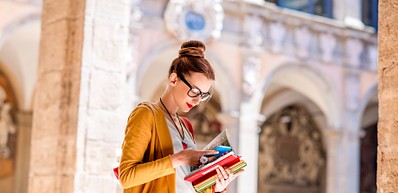
-
![Four skulls in a raw showing humans evolution. Human evolution is the evolutionary process that led to the emergence of anatomically modern humans.]() Provided by: JuliusKielaitis/Shutterstock.com
Provided by: JuliusKielaitis/Shutterstock.com

Our travel guides are free to read and explore online. If you want to get your own copy, the full travel guide for this destination is available to you offline* to bring along anywhere or print for your trip.
*this will be downloaded as a PDF.Price
€4,95
Anatomy Museum
The guide was updated:The Anatomy Museum, Collezione delle Cere Anatomiche, offers a unique and spine-chilling experience. Visitors will encounter displays featuring wax models depicting body parts, diseases, and malformations, alongside a vast collection of real skulls. Recommended for those with interests in medical history, anatomy, or general health. Be aware that the museum may not be suitable for the overly squeamish.
Useful Information
- Address: Via Irnerio 48, Bologna
- Website: sma.unibo.it/it/il-sistema-museale/collezione-delle-cere-anatomiche-l-cattaneo
- Phone: +39 051 209 1556
Digital Travel Guide Download
Our travel guides are free to read and explore online. If you want to get your own copy, the full travel guide for this destination is available to you offline* to bring along anywhere or print for your trip.
*this will be downloaded as a PDF.Price
€4,95

Le due Torri (The Two Towers), Garisenda e degli Asinelli, are iconic symbols of Bologna's skyline, dating back to the 12th century. Towering over the city, they stand as testament to Bologna's medieval heritage and architectural splendour. While the Garisenda Tower is known for its distinctive lean, the Asinelli Tower offers breathtaking panoramic views from its summit.
Read more

Bologna’s Town Hall
The Palazzo Comunale (or Palazzo d'Accursio) is Bologna’s town hall. The upper level of the palace is the home of the civic museum Collezioni Comunali d'Arte (Municipal Art Collections) where a large collection of Renaissance paintings and other pieces of art can be enjoyed.
Read more

National Gallery
The National Gallery (Pinacoteca Nazionale) is the most important art gallery in Bologna and boasts one of the richest collections in Northern Italy. Art from major Italian artists, including local artists are housed here. Here you will find works of art, dating back from the 14th and 15th centuries to the Renaissance period and art from the 16th century.
Read more

Basilica of San Petronio
Standing on Bologna’s main square, (Piazza Maggiore), the Basilica of San Petronio is one of the largest medieval churches in Italy and an important symbol of the city. The inside is full of Gothic archways, stained glass windows and doors from the 15th and 16th centuries.
Read more

Basilica of Santo Stefano
This extraordinary religious site consists of four medieval churches, originally there were seven churches, and therefore it is known by the name of Sette Chiese (Seven Churches). Besides churches, this peaceful complex contains cloisters, tombs and courtyards, a great place to browse religious art and artefacts as well. The most interesting is the church of the Sepolcro, which preserves a representation of the Holy Sepulchre of Jerusalem.
Read more

University of Bologna
The University of Bologna, founded in 1088, stands as the oldest university in the Western world, boasting a rich history of academic excellence and innovation. Some of the famous people who have been teaching here include Nicolaus Copernicus and Francesco Petrarca. Renowned for its distinguished faculty, diverse student body, and commitment to research and teaching across a wide range of disciplines, the University of Bologna continues to be a global leader in higher education.
Read more

Fountain of Neptune
Crafted by the skilled sculptor Giambologna in the 16th century, the colossal Fontana di Nettuno graces the heart of Piazza Maggiore with its majestic presence. The life-size bronze statue of Neptune, poised atop a shell-shaped chariot pulled by seahorses and surrounded by allegorical figures, exudes a sense of power and elegance. Serving as an iconic landmark of Bologna, the fountain not only embodies the city's rich artistic heritage but also functions as a gathering point for residents and tourists to appreciate the intersection of art, history, and civic life in this charming Italian city.
Read more

Basilica of San Domenico
Built in 1251, this is the birthplace of the Dominican order and the resting place of its founder — Saint Dominic. It is one of the richest churches in Bologna when it comes to history and art. The small museum houses art and precious artefacts like the relic of Louis IX of France. Be sure to also admire the beautiful Romanesque façade and Gothic chapels.
Read more

Italian Cooking Class
If you want to learn how to cook a perfect pasta Bolognese, there's no better place to do it than in Bologna, the home of the world’s famous sauce. Agriturismo San Giuliano organizes classes in pasta making and cooking traditional Italian food. The courses can be held in Italian, English, French or Spanish.
Read more

Ducati Museum
If motorcycles fascinate you, the Ducati Museum, on the outskirts of Bologna, is a must. At the Ducati Factory, you can see the history of this world-famous brand from the year of 1926 until today. You can also join the factory tour, just make sure to book in advance.
Read more

Certosa di Bologna
The Certosa di Bologna is a former Carthusian monastery, which was founded in 1334 and suppressed in 1797. In 1801, it became the city's Monumental Cemetery, which is known for its unique sculptures, architecture and Etruscan tombs. Just beside the graveyard, you can find the area where the non-Catholic persons were buried, a Jewish cemetery, and a crematory area.
Read more

MAMbo — Bologna Modern Art Museum
Opened in 2007, MAMbo is housed within a former industrial space constructed in 1915, which previously operated as a bakery for many years. The museum features a diverse collection showcasing art from World War II to the present, featuring renowned Italian and foreign artists.
Read more

Ferrari Maranello Museum
The Italians see their luxury car brand Ferrari as a religion and their beautiful cars as saints. In the city of Maranello just outside Bologna, you can find its factory. In a separate building next to it, a 2,500 square meter museum welcomes guests to discover the history of the brand and to be fascinated by the fast cars.
Read more

Bologna Municipal Theater
Inaugurated in 1763, The Teatro Comunale di Bologna is the heart of Bologna's cultural life and is considered to be one of the most important opera venues in Italy. Opera, ballet, symphonic concerts or contemporary music, regardless of what you choose, will be a cultural high point to remember.
Read more

Lamborghini Automobile Museum
Located in Sant'Agata Bolognese, the birthplace of Lamborghini, the museum offers visitors a fascinating journey through decades of cutting-edge design and engineering. Showcasing a striking collection of Lamborghini's legendary sports cars, including sleek models and prototypes, the museum provides automobile enthusiasts with a close-up look at the brand's evolution.
Read more

Park of Montagnola
Park of Montagnola (Parco della Montagnola) is an enchanting green space nestled in the heart of the city. With its lush vegetation, meandering pathways, and charming pond, the park provides a picturesque setting for leisurely strolls, picnics, or simply basking in the beauty of nature.
Read more

Anatomical Theatre
The Anatomical Theatre is a former classroom, in the shape of an amphitheatre, used for anatomy lectures and dissections during the 16th century. Immerse yourself in the richly panelled space adorned with detailed wood sculptures for a glimpse into the educational practices of the past.
Read more

Anatomy Museum
The Anatomy Museum, Collezione delle Cere Anatomiche, offers a unique and spine-chilling experience. Visitors will encounter displays featuring wax models depicting body parts, diseases, and malformations, alongside a vast collection of real skulls. Recommended for those with interests in medical history, anatomy, or general health. Be aware that the museum may not be suitable for the overly squeamish.
Read more

Golf Club Bologna
If you want to play a game of golf you can go to the historical 50-year-old Golf Club Bologna. This is a good place to go to experience the beautiful Bolognese countryside. The last three holes are claimed to be a real challenge. When hunger kicks in, there is a restaurant and bar in the clubhouse where to relish culinary delicacy in a relaxed ambience.
Read more

Renato Dall'Ara Stadium
Also known as, Stadio Littorialeis, Stadio Renato Dall'Ara is a multi-purpose stadium, currently used mostly for football matches and the home of Bologna F.C. It was established in 1927 and has a capacity of over 38,000 people and even though the stadium is old, the condition and facilities are good. Concerts are also held at this stadium.
Read more

Terme San Luca — Pluricenter
Terme San Luca boasts the largest spa centre in Bologna, offering a comprehensive array of amenities for wellness and fitness enthusiasts alike. From rejuvenating pools to gym facilities and solariums, guests can indulge in a range of activities designed for relaxation and remise-en-forme.
Read more


